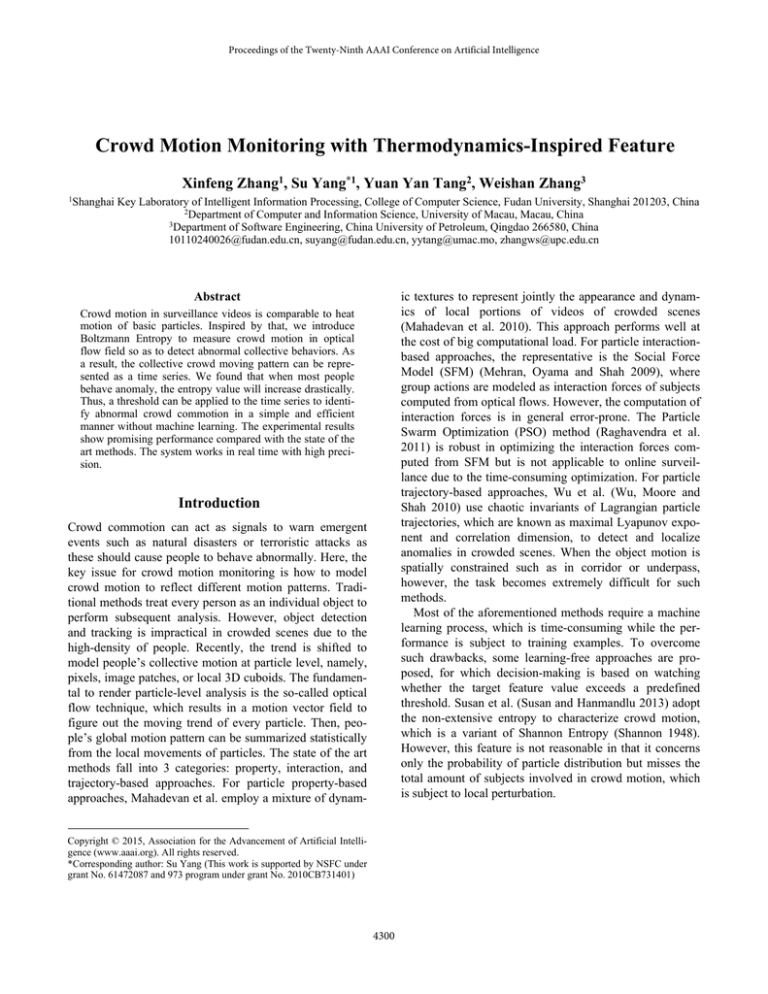
Proceedings of the Twenty-Ninth AAAI Conference on Artificial Intelligence
Crowd Motion Monitoring with Thermodynamics-Inspired Feature
Xinfeng Zhang1, Su Yang*1, Yuan Yan Tang2, Weishan Zhang3
1Shanghai
Key Laboratory of Intelligent Information Processing, College of Computer Science, Fudan University, Shanghai 201203, China
2Department of Computer and Information Science, University of Macau, Macau, China
3
Department of Software Engineering, China University of Petroleum, Qingdao 266580, China
10110240026@fudan.edu.cn, suyang@fudan.edu.cn, yytang@umac.mo, zhangws@upc.edu.cn
ic textures to represent jointly the appearance and dynamics of local portions of videos of crowded scenes
(Mahadevan et al. 2010). This approach performs well at
the cost of big computational load. For particle interactionbased approaches, the representative is the Social Force
Model (SFM) (Mehran, Oyama and Shah 2009), where
group actions are modeled as interaction forces of subjects
computed from optical flows. However, the computation of
interaction forces is in general error-prone. The Particle
Swarm Optimization (PSO) method (Raghavendra et al.
2011) is robust in optimizing the interaction forces computed from SFM but is not applicable to online surveillance due to the time-consuming optimization. For particle
trajectory-based approaches, Wu et al. (Wu, Moore and
Shah 2010) use chaotic invariants of Lagrangian particle
trajectories, which are known as maximal Lyapunov exponent and correlation dimension, to detect and localize
anomalies in crowded scenes. When the object motion is
spatially constrained such as in corridor or underpass,
however, the task becomes extremely difficult for such
methods.
Most of the aforementioned methods require a machine
learning process, which is time-consuming while the performance is subject to training examples. To overcome
such drawbacks, some learning-free approaches are proposed, for which decision-making is based on watching
whether the target feature value exceeds a predefined
threshold. Susan et al. (Susan and Hanmandlu 2013) adopt
the non-extensive entropy to characterize crowd motion,
which is a variant of Shannon Entropy (Shannon 1948).
However, this feature is not reasonable in that it concerns
only the probability of particle distribution but misses the
total amount of subjects involved in crowd motion, which
is subject to local perturbation.
Abstract
Crowd motion in surveillance videos is comparable to heat
motion of basic particles. Inspired by that, we introduce
Boltzmann Entropy to measure crowd motion in optical
flow field so as to detect abnormal collective behaviors. As
a result, the collective crowd moving pattern can be represented as a time series. We found that when most people
behave anomaly, the entropy value will increase drastically.
Thus, a threshold can be applied to the time series to identify abnormal crowd commotion in a simple and efficient
manner without machine learning. The experimental results
show promising performance compared with the state of the
art methods. The system works in real time with high precision.
Introduction
Crowd commotion can act as signals to warn emergent
events such as natural disasters or terroristic attacks as
these should cause people to behave abnormally. Here, the
key issue for crowd motion monitoring is how to model
crowd motion to reflect different motion patterns. Traditional methods treat every person as an individual object to
perform subsequent analysis. However, object detection
and tracking is impractical in crowded scenes due to the
high-density of people. Recently, the trend is shifted to
model people’s collective motion at particle level, namely,
pixels, image patches, or local 3D cuboids. The fundamental to render particle-level analysis is the so-called optical
flow technique, which results in a motion vector field to
figure out the moving trend of every particle. Then, people’s global motion pattern can be summarized statistically
from the local movements of particles. The state of the art
methods fall into 3 categories: property, interaction, and
trajectory-based approaches. For particle property-based
approaches, Mahadevan et al. employ a mixture of dynam-
Copyright © 2015, Association for the Advancement of Artificial Intelligence (www.aaai.org). All rights reserved.
*Corresponding author: Su Yang (This work is supported by NSFC under
grant No. 61472087 and 973 program under grant No. 2010CB731401)
4300
Table 1. Comparison of the proposed method to the baseline
methods (Entropy: Non-extensive Entropy; Sparse: Sparse Reconstruction Cost: PSO: PSO-SFM; OF: Optical Flow)
The Boltzmann Entropy to Feature Crowd
Motion for Anomaly Detection
The present features are not robust enough as they do not
reflect the physical nature of crowd motion. Intuitively,
crowd motion in surveillance videos is comparable to heat
motion of basic particles such as molecules in terms of
thermodynamics. Inspired by Boltzmann Entropy (Halliday,
Resnick and Walker 2010), we apply it to measure the spatio-temporal motion of particles following optical flow
computation. As shown in Figure 1, when abnormal crowd
movement occurs, Boltzmann Entropy will increase drastically. Accordingly, anomaly can be alarmed as lowprobability event of rarely appeared big increment of
Boltzmann Entropy, where we employ Gaussian model for
decision-making and machine learning is not needed.
Methods
Ours
0.985
AUC
Speed (fps) 5
Entropy
0.95
4
Sparse
0.978
<1
PSO
0.996
<<1
SFM
0.96
3
OF
0.84
5
Table 2. The confusion matrix (%)
Events
Normal
Abnormal
Normal
93.32
5.05
Abnormal
6.68
94.95
Conclusion
We introduce Boltzmann Entropy to capture the chaos degree of crowd behavior for video surveillance. It is extracted from optical flow directly without the need to detect or
track objects individually. As the crowd motion is represent as a single time series, only a threshold is needed for
decision making, which is free of machine learning. Its
high-speed computation enables real-time monitoring.
References
Andrade, E. L., Blunsden, S. and Fisher, R. B. 2006. Modelling
crowd scenes for event detection. In Proceedings of the Pattern
Recognition, 2006. ICPR 2006. 18th International Conference on,
175-178.
Halliday, D., Resnick, R. and Walker, J. 2010. Fundamentals of
physics extended 9 edition. Wiley: 550-560
Mahadevan, V., Weixin, L., Bhalodia, V. and Vasconcelos, N.
2010. Anomaly detection in crowded scenes. In Proceedings of
the Computer Vision and Pattern Recognition (CVPR), 2010
IEEE Conference on, 1975-1981.
Mehran, R., Oyama, A. and Shah, M. 2009. Abnormal crowd
behavior detection using social force model. In Proceedings of
the Computer Vision and Pattern Recognition, 2009. CVPR 2009.
IEEE Conference on, 935-942.
Raghavendra, R., Del Bue, A., Cristani, M. and Murino, V. 2011.
Optimizing interaction force for global anomaly detection in
crowded scenes. In Proceedings of the Computer Vision Workshops (ICCV Workshops), 2011 IEEE International Conference
on, 136-143.
Shannon, C. E. 1948. A mathematical theory of communication.
Bell System Technical Journal, 27: 379-423.27.
Susan, S. and Hanmandlu, M. 2013. Unsupervised detection of
nonlinearity in motion using weighted average of non-extensive
entropies. Signal, Image and Video Processing: 1-15
Wu, S., Moore, B. E. and Shah, M. 2010. Chaotic invariants of
lagrangian particle trajectories for anomaly detection in crowded
scenes. In Proceedings of the Computer Vision and Pattern
Recognition (CVPR), 2010 IEEE Conference on, 2054-2060.
Yang, C., Junsong, Y. and Ji, L. 2011. Sparse reconstruction cost
for abnormal event detection. In Proceedings of the Computer
Vision and Pattern Recognition (CVPR), 2011 IEEE Conference
on, 3449-3456.
Figure 1. Time series of entropy values against video clips (Blue
one: Boltzmann Entropy; Green one: Shannon Entropy). The
shadows show the lasting time of crowd commotion. The online
monitoring images attached to the peaks of the corresponding
curves show that Boltzmann Entropy is more reasonable.
Experiments
With UMN data (http://mha.cs.umn.edu/movies/crowdactivity-all.avi), a comparison of our method with Nonextensive Entropy (Susan and Hanmandlu 2013), Sparse
Reconstruction Cost method (Yang, Junsong and Ji 2011),
Particle Swarm Optimization based Social Force Model
(PSO-SFM) (Raghavendra et al. 2011), Social Force Model (Mehran, Oyama and Shah 2009), and Optical Flow
methods (Andrade, Blunsden and Fisher 2006) is done in
terms of both the averaged AUC (area under ROC curve)
and the speed. It is shown in Table 1 that our method outperforms all the methods except the PSO-SFM but the
speed of PSO-SFM is much slower than ours. This makes
PSO-SFM impractical for online monitoring but our method works.
Table 2 shows the confusion matrix in identifying normal and abnormal behaviors on UMN and PETS2009 S3
dataset (http://www.cvg.rdg.ac.uk/PETS2009). The false
alarm and missing rate is 6.68% and 5.05%, respectively.
The performance is high.
4301






